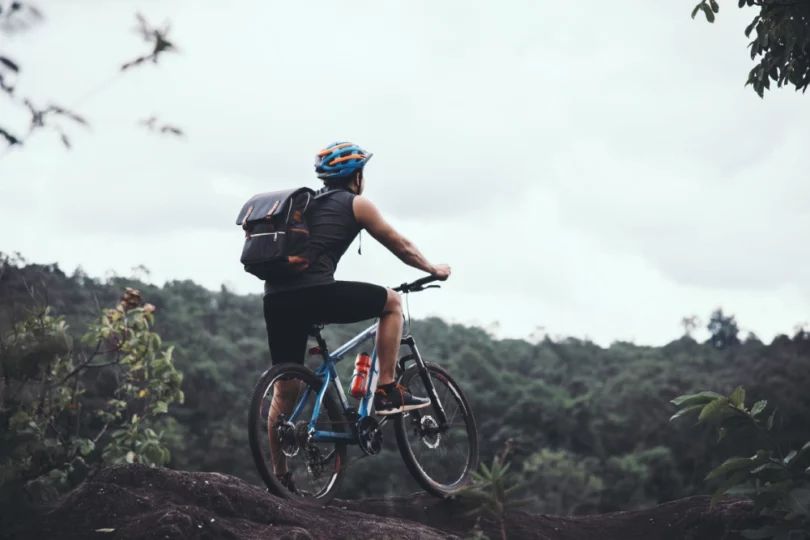So you’ve signed up for that epic bike ride you have always dreamed of. While the excitement is bubbling, a little voice whispers, “Am I ready?”
Fear not, fellow adventurer! Here we shared how to prepare for a long bike ride.
With this guide, you’ll be pedaling your way to success like a seasoned pro.
How to Prepare for a Long Bike Ride?
Start slow and steady
Never think that you will turn from a couch potato to an enduro hero in a few days. Increase your riding distance and intensity gradually each week.
Listen to your body and take breaks when needed. Your body will thank you for it.
Remember, it’s a marathon, not a sprint.
Fuel your engine
Carbs are your best friend before, during, and after a long ride. Pack energy-rich snacks like bananas, granola bars and energy gels to keep your legs pumping.
Hydrate, Hydrate, Hydrate!
Water is your lifeline when you’re out on the road for a long time. Carry plenty of water and sip regularly, even if you don’t feel thirsty.
Remember, hydration is key. Take enough fluids every day, especially on hot days. Dehydration can quickly turn your ride into a struggle.
Gear up
Don’t let a flat tire or a broken chain derail your adventure. Pack a basic repair kit, including spare inner tubes, a pump, and a multi-tool.
Choose comfortable clothes that wick away sweat and offer protection from the elements.
Invest in comfortable, padded cycling shorts to save your backside from becoming acquainted with your saddle. Helmets are non-negotiable and don’t forget sunscreen and sunglasses to protect yourself from the UV rays.
Pack smart
Pack light with only the essentials. Avoid overloading your saddlebags with unnecessary items because a heavy bike will require more energy and you may end up being too tired to finish the ride.
A spare jersey and a pair of shorts, a rain jacket, and a map or a GPS device are good additions. Remember, the more you carry, the more you have to pedal.
Be mindful of the weather
Check the forecast before you head out. Dress appropriately and be prepared for unexpected weather changes.
If you are caught in a sudden downpour, put on a lightweight rain jacket and find shelter if necessary.
Ride with a buddy
Safety in numbers! Having a friend or family member along with you can not only be more fun but also provide valuable assistance in case something unexpected happens. What’s more, sharing the experience can create lasting memories.
Stay alert and aware
Don’t let your guard down. Be aware of your surroundings and traffic conditions. Use hand signals to indicate your turns and stay on designated bike lanes whenever possible.
Take in the scenery
Remember, the journey is just as important as the destination. Slow down and appreciate the beauty around you.
Take photos, smell the flowers, listen to the sounds of nature. This is your time to escape the daily grind and your surroundings.
Celebrate your success
You’ve conquered the miles and reached your goal. Take a moment to pat yourself on the back.
Celebrate your accomplishment and share your experience with others. Let this be a springboard for your next adventure, pushing your boundaries and discovering new horizons.
Training for Long Distance Riding: Your Guide to Conquering the Road
Long-distance cycling is a challenging but a rewarding experience. You get to see the world from a different perspective, push your physical limits, and create lasting memories. However, it requires a significant amount of training and preparation.
Here’s how to prep yourself up:
Interval training:
- Improve your power and speed: Interval training involves alternating between periods of high intensity and low intensity.
- Start with short intervals: Begin with short intervals, such as first do a 30-second sprint and then go easy for 30 seconds.
- Gradually increase the duration and intensity: As your fitness improves, increase the duration and intensity of your intervals.
Hill training:
- Build leg strength: Climbing stairs or hills is a great way to build leg strength and endurance.
- Find hills in your area: If there are hills in your area, try riding uphill or find dedicated hill training sessions e.g. treadmill incline workouts.
- Start with shorter climbs: Try shorter and less steep climbs first and then gradually progress to longer and steeper hills.
Additional tips:
- Invest in a good bike: A good bike will help make your rides more comfortable and enjoyable.
- Get fitted: A proper bike fit can help prevent injuries and improve your performance.
- Practice your bike handling skills: Learn how to shift gears, brake effectively, and corner safely.
- Plan your route: Plan your route in advance and make sure you are familiar with the terrain.
- Tell someone where you are going: Let someone know where you are going and when you expect to be back.
- Be prepared for emergencies: Carry a basic repair kit and first-aid supplies.
Most importantly, have fun! Long-distance cycling should be enjoyable. Don’t put too much pressure on yourself and focus on enjoying the ride.
By following these tips, you can train effectively for your long-distance cycling goals and set yourself up for success. Remember, preparation is key; so, be patient, consistent, and enjoy the process!
Clothing essentials for your bike tour
When learning how to prepare for a long bike ride, you also need to know what to wear in different weather conditions to make the tour a pleasant one. Here’s a guide to essential clothing for your next long-distance cycling adventure –
Base Layer
A good base layer is the foundation of any cycling outfit.
Choose a breathable, moisture-wicking fabric that will keep you cool and dry in warm weather and warm and comfortable in cooler temperatures.
Merino wool is a popular option for its natural odor-resistant properties.
Cycling Jersey
A cycling jersey is designed specifically for the needs of cyclists.
It features a close-fitting cut to reduce wind resistance and back pockets for storing snacks and other essentials.
Choose a jersey made from a breathable fabric with good moisture-wicking properties.
Bib shorts
Don’t forget about bib shorts since they offer a more comfortable fit than traditional cycling shorts with paddings to protect your sensitive areas.
Look for bib shorts with a high-quality chamois pad that is designed for long rides only.
Leg warmers
Leg warmers are a versatile piece of gear that can be added or removed as needed to adjust to changing temperatures.
They are also helpful for protecting your legs from sunburns and insect bites.
Arm warmers
Arm warmers are similar to leg warmers and can be used to add warmth and protection to your arms.
They are especially useful for early morning or late night rides when the temperature is cooler.
Windbreaker
A windbreaker is essential for protecting yourself from the wind and rain.
Choose a lightweight, packable windbreaker that can be easily stowed in your jersey pocket when not needed.
Rain Jacket
A rain jacket is necessary for unexpected downpours. Look for a waterproof and breathable rain jacket that will keep you dry without causing you to overheat.
Cycling gloves and socks
Cycling gloves provide padding and protection for your hands. They also help improve your grip on the handlebars.
Cycling socks are designed to consume moisture and prevent blisters. Choose socks made from a synthetic fabric with good ventilation.
Sunglasses
Sunglasses are essential for protecting your eyes from the sun and wind. Choose sunglasses with polarized lenses to reduce glare.
Conclusion
Long distance cycling requires careful preparation and the right gear.
By following this guide on how to prepare for a long bike ride, you can train effectively, choose the right clothing and ensure a successful and enjoyable adventure.
So, get out there and explore the world on two wheels!
FAQs
Q. What type of bike is best for long-distance riding?
Ans. There are several types of bikes that are well-suited for long-distance riding, including touring bikes, endurance road bikes, and gravel bikes.
Touring bikes are specifically designed for long-distance comfort and stability, and they often have features such as multiple frame mounts for carrying gear, wider tires for smooth riding on rough terrain, and a more upright riding position.
Endurance road bikes are designed for long days in the saddle, with a slightly more relaxed geometry than a traditional road bike and features such as wider tire clearance and vibration-damping technology.
Gravel bikes are a versatile option that can handle both paved and unpaved roads, making them a good choice for long-distance rides that include mixed terrain.
Q. How much training do I need to do for a long-distance ride?
Ans. The amount of training you need to do for a long-distance ride will depend on several factors, including your current fitness level, the length of the ride, and the terrain you will be riding on.
A good rule of thumb is to start training at least a few months in advance and gradually increase the distance and intensity of your rides.
If you are new to cycling, it is a good idea to consult with a coach or trainer to help you create a training plan.
Q. What should I eat and drink during a long-distance ride?
Ans. It is important to eat and drink regularly during a long-distance ride to prevent fatigue and maintain your energy levels.
Focus on consuming foods that are high in complex carbohydrates, lean protein, and healthy fats. Good options include fruits, vegetables, whole grains, nuts, seeds, and energy bars.
It is also important to stay hydrated by drinking plenty of water and electrolyte-rich sports drinks.







